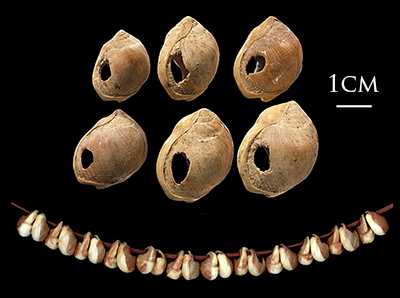Shell jewelry

.jpg)
Shell jewelry is jewelry which in this case is primarily made from seashells, the shells of marine mollusks. Shell jewelry is a type of shellcraft. One very common form of shell jewelry is necklaces that are composed of large numbers of beads, where each individual bead is the whole (but often drilled) shell of a small sea snail. Numerous other varieties of shell jewelry are made, including bracelets and earrings. Occasionally shell jewelry is made from the shells of land snails , or the shells of freshwater mollusks.
Shell jewelry also uses the shells of clams (bivalves) and sometimes uses tusk shells (scaphopods). Not all shell jewelry is made from whole shells; some kinds are made from parts of shells, including the shell layer known as mother of pearl or nacre.
In recent times, inexpensive shell jewelry is often for sale at tropical beach destinations, where it is offered to tourists as informal wear or as a souvenir. However, shell jewelry has a very ancient past and is of great importance in archeology and anthropology. In fact, shell beads are the oldest form of jewelry know, dating back over 100,000 years.
In prehistory
The oldest known jewelry in the world consists of two perforated beads made from shells of the sea snail Nassarius gibbosulus. These beads were discovered at Skhul in Israel, and were recently dated to between 100,000 and 135,000 years ago.[1][2] Similar ornaments (some made from shells of Nassarius kraussianus and the bittersweet clam Glycymeris nummaria as well as from Nassarius gibbosulus) have been discovered at a number of Middle Paleolithic sites, and are considered a key piece of evidence for the theory that early anatomically modern humans in Africa and the Levant were more culturally sophisticated than had previously been thought.[3][4][5] In some cases shells had been transported a considerable distance from the species' natural habitat. One example is the site of Oued Djebbana in Algeria, for example, where an N. gibbosulus bead was found; at the time the shell was used there, this site was at least 190 km away from the sea.[2]

Shell ornaments were very common during the Upper Paleolithic, from 50–40,000 years ago onwards, when they spread with modern humans to Europe and Asia. They generally take the form of perforated shells (as well as other hard organic material such as tooth, bone, antler and mammoth ivory) which are thought to have been suspended and used as jewelry. The most commonly found species are Homalopoma sanguineum, Littorina obtusata, Cyclope species, Nassarius mutabilis and Nassarius gibbosulus. Fossil shells were used alongside those of contemporary species. Some shells were stained with ochre. In Europe, the shells of both Atlantic and Mediterranean species were used, again circulating over distances of hundreds of kilometers.[6]
See also
| Wikimedia Commons has media related to Jewellery made with sea shells. |
References
- ↑ Balter, M. (Jun 2006). "Archaeology. First jewelry? Old shell beads suggest early use of symbols.". Science 312 (5781): 1731. doi:10.1126/science.312.5781.1731. ISSN 0036-8075. PMID 16794051.
- ↑ 2.0 2.1 Vanhaereny, M.; d'Errico, F.; Stringer, C.; James, S. L.; Todd, J. A.; Mienis, H. K. (2006). "Middle Paleolithic Shell Beads in Israel and Algeria". Science 312 (5781): 1785–1788. doi:10.1126/science.1128139. PMID 16794076.
- ↑ d'Errico, F.; Henshilwood, C.; Vanhaeren, M.; Van Niekerk, K. (2005). "Nassarius kraussianus shell beads from Blombos Cave: Evidence for symbolic behaviour in the Middle Stone Age". Journal of Human Evolution 48 (1): 3–24. doi:10.1016/j.jhevol.2004.09.002. PMID 15656934.
- ↑ Bouzouggar, A.; Barton, N.; Vanhaeren, M.; d'Errico, F.; Collcutt, S.; Higham, T.; Hodge, E.; Parfitt, S.; Rhodes, E.; Schwenninger, J. -L.; Stringer, C.; Turner, E.; Ward, S.; Moutmir, A.; Stambouli, A. (2007). "82,000-year-old shell beads from North Africa and implications for the origins of modern human behavior". Proceedings of the National Academy of Sciences 104 (24): 9964. doi:10.1073/pnas.0703877104.
- ↑ d'Errico, F.; Vanhaeren, M.; Barton, N.; Bouzouggar, A.; Mienis, H.; Richter, D.; Hublin, J. -J.; McPherron, S. P.; Lozouet, P. (2009). "Out of Africa: Modern Human Origins Special Feature: Additional evidence on the use of personal ornaments in the Middle Paleolithic of North Africa". Proceedings of the National Academy of Sciences 106 (38): 16051. doi:10.1073/pnas.0903532106.
- ↑ Fernández, Esteban Álvarez; Jöris, Olaf (2007). "Personal Ornaments in the Early Upper Paleolithic of Western Eurasia: an Evaluation of the Record". Eurasian Prehistory 5 (2): 31–44.
Further reading
- Roger Neich, 2004 Pacific Jewelry and Adornment, University of Hawaii Press, 189 pp.
| ||||||||||||||||||||||||||||||||||||||||||||||||||||||
.jpg)